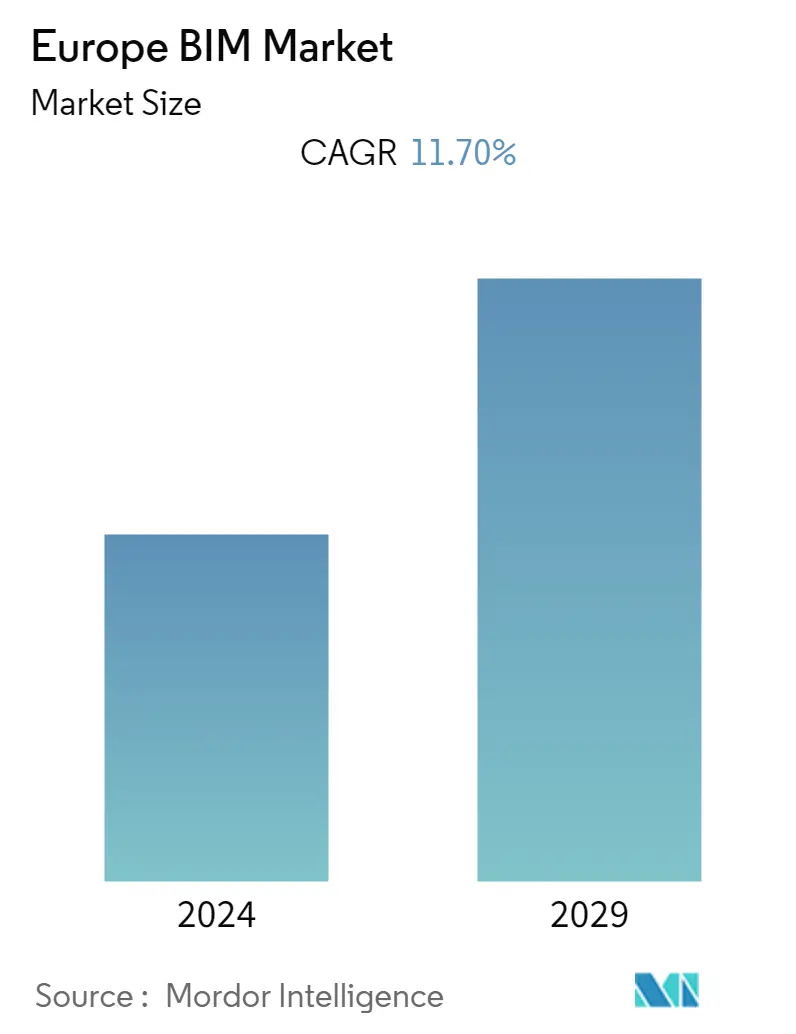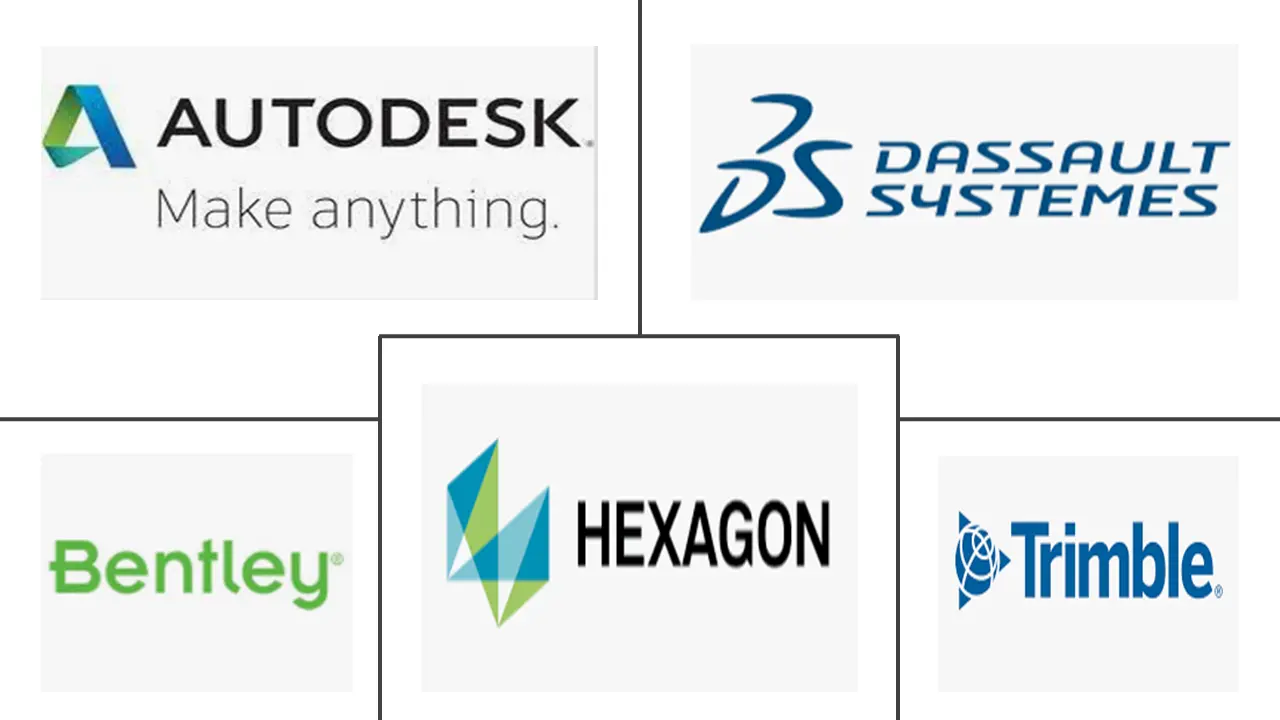Market Size of Europe BIM Industry

| Study Period | 2019 - 2029 |
| Base Year For Estimation | 2023 |
| Forecast Data Period | 2024 - 2029 |
| Historical Data Period | 2019 - 2022 |
| CAGR | 11.70 % |
| Market Concentration | Medium |
Major Players
*Disclaimer: Major Players sorted in no particular order |
Europe Building Information Modelling Market Analysis
The European building information modeling (BIM) market registered a CAGR of 11.7% during the forecast period, 2022-2027. The demand for BIM solutions is partly dependent on the construction activity witnessed in a region, and in the UK, it has recovered significantly after the economic recession to emerge as one of the major sectors of the economy. The UK has been one of the early adopters of BIM solutions, with the general services administration taking several proactive measures to promote the usage of BIM solutions.
- The usage of BIM has become more common in the AEC industry due to the numerous benefits connected with this technology. Because of the fragmented delivery methods, building problems, and various parties involved in the process, the contemporary AEC business is complicated, allowing for the widespread use of BIM. This is mostly due to a growth in the number of government laws pertaining to BIM adoption in the AEC industry, as well as the growing need for automated models in the construction arena to improve operational efficiencies.
- BIM-supporting technology and methods are continually emerging in the building sector. The concept of BIM integration with AR/VR, where users may view and interact with a virtual world, has grown in popularity. The growing popularity of BIM integration with AR/VR is good for market growth since it enhances communication among stakeholders and provides better visualization for designers, engineers, and other stakeholders, allowing for a one-to-one, completely immersive experience.
- The COVID-19 pandemic had had little influence on the expansion of the building information modeling business since the COVID-19 lockdown allowed for widespread adoption of BIM, allowing projects to proceed in a virtual and digital environment even when participants were unable to meet in person. The epidemic has compelled people to seek out safer and more efficient methods to construct offices and houses.
- Policies and regulations implemented by governments for the deployment of BIM solutions in the construction of public and private infrastructure across different countries in this region foster the growth of the BIM market. In Europe, in most countries, the use of BIM for commercial projects has been made mandatory.
Europe Building Information Modelling Industry Segmentation
Building information modeling (BIM) is a 3D model-based process for creating and managing information on a construction project across the project lifecycle. The important outputs of this process are the building Information model and the digital description of every aspect of the built asset to manage the building infrastructure in a better way.
The European building information modeling market is segmented by type (software and services), deployment type (on-premise and cloud), application (commercial, residential, and industrial), and country.
| By Type | |
| Software | |
| Services |
| By Deployment Type | |
| On-premise | |
| Cloud |
| By Application | |
| Commercial | |
| Residential | |
| Industrial |
| By Country | |
| United Kingdom | |
| Germany | |
| France | |
| Rest of Europe |
Europe BIM Market Size Summary
The European building information modeling (BIM) market is experiencing significant growth, driven by the increasing adoption of BIM solutions in the architecture, engineering, and construction (AEC) industry. This growth is largely attributed to the complexities of modern construction projects, which involve multiple parties and fragmented delivery methods. The integration of BIM with emerging technologies such as augmented reality (AR) and virtual reality (VR) is enhancing stakeholder communication and visualization, further propelling market expansion. Government policies across Europe mandating BIM usage for commercial projects are also contributing to the market's robust development. The COVID-19 pandemic has accelerated the adoption of BIM, as it facilitated virtual project management and collaboration, highlighting the technology's role in ensuring continuity and efficiency in construction activities.
The market landscape is highly competitive, with numerous small and large vendors offering BIM solutions both domestically and internationally. Major players like Autodesk Inc., Bentley Systems Inc., Dassault Systèmes SA, and Hexagon AB are focusing on product and service innovation, as well as strategic mergers and acquisitions, to strengthen their market positions. The introduction of IoT technologies in construction is streamlining processes and enhancing safety, while cloud-based software solutions are enabling remote project management and collaboration. Partnerships and acquisitions, such as AVEVA's collaboration with RIB Software and Bentley Systems' acquisition of SPIDA Software, are further driving innovation and expanding capabilities within the BIM market. These developments underscore the dynamic nature of the European BIM market, characterized by continuous technological advancements and strategic industry collaborations.
Europe BIM Market Size - Table of Contents
-
1. MARKET INSIGHTS
-
1.1 Market Overview
-
1.2 Value Chain/Supply Chain Analysis
-
1.3 Industry Attractiveness - Porter's Five Forces Analysis
-
1.3.1 Threat of New Entrants
-
1.3.2 Bargaining Power of Buyers
-
1.3.3 Bargaining Power of Suppliers
-
1.3.4 Threat of Substitute Products
-
1.3.5 Intensity of Competitive Rivalry
-
-
1.4 Assessment of the COVID-19 Impact on the Industry
-
-
2. MARKET SEGMENTATION
-
2.1 By Type
-
2.1.1 Software
-
2.1.2 Services
-
-
2.2 By Deployment Type
-
2.2.1 On-premise
-
2.2.2 Cloud
-
-
2.3 By Application
-
2.3.1 Commercial
-
2.3.2 Residential
-
2.3.3 Industrial
-
-
2.4 By Country
-
2.4.1 United Kingdom
-
2.4.2 Germany
-
2.4.3 France
-
2.4.4 Rest of Europe
-
-
Europe BIM Market Size FAQs
What is the current Europe BIM Market size?
The Europe BIM Market is projected to register a CAGR of 11.70% during the forecast period (2024-2029)
Who are the key players in Europe BIM Market?
Autodesk, Inc., Dassault Systèmes SE, Bentley Systems, Hexagon AB and Trimble Inc. are the major companies operating in the Europe BIM Market.

